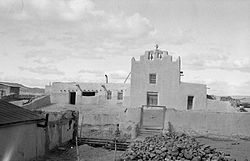

This is a list of properties and districts in New Mexico that are on the National Register of Historic Places . There are more than 1,100 listings. Of these, 46 are National Historic Landmarks. There are listings in each of the state's 33 counties.
Contents
The tables linked below are intended to provide a complete list of properties and districts listed in each county. The locations of National Register properties and districts with latitude and longitude data may be seen in an online map by clicking on "Map of all coordinates". [a]
The names on the lists are as they were entered into the National Register; some place names are uncommon or have changed since being added to the National Register.
This National Park Service list is complete through NPS recent listings posted September 12, 2025. [1]


